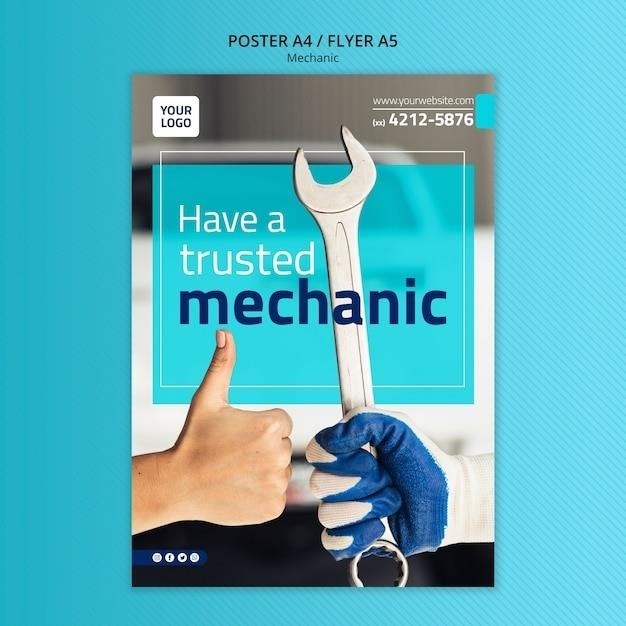mercury 90hp 2-stroke service manual pdf free download
Mercury 90hp 2-Stroke Service Manual PDF Free Download⁚ A Comprehensive Guide
This guide delves into the essential information you need to know about the Mercury 90hp 2-stroke service manual, including where to find it, its key features, and the benefits of using it․ We’ll cover everything from routine maintenance to complex repairs, ensuring you have the knowledge to keep your outboard engine running smoothly․
Introduction
Owning a Mercury 90hp 2-stroke outboard motor is a testament to your passion for boating․ These powerful engines are known for their performance and reliability, but like any mechanical marvel, they require proper care and maintenance․ This is where a service manual comes in handy․ A Mercury 90hp 2-stroke service manual is your indispensable guide to understanding the intricacies of your engine, from basic maintenance to more complex repairs․ It provides detailed instructions, diagrams, and troubleshooting tips, empowering you to keep your engine running smoothly and efficiently for years to come․
Why You Need a Mercury 90hp 2-Stroke Service Manual
A Mercury 90hp 2-stroke service manual is more than just a collection of instructions; it’s your trusted companion for ensuring the longevity and optimal performance of your outboard motor․ This comprehensive manual serves as a vital resource for both novice and experienced boaters, providing the necessary knowledge to perform routine maintenance tasks, troubleshoot issues, and execute complex repairs․ By having access to detailed diagrams, specifications, and step-by-step procedures, you’ll be equipped to address any challenges that arise, minimizing downtime and maximizing your enjoyment on the water․
Where to Find a Mercury 90hp 2-Stroke Service Manual
Securing a Mercury 90hp 2-stroke service manual is easier than you might think․ Several avenues are available to obtain this invaluable resource․ Online resources offer a wealth of options, with websites specializing in marine manuals providing downloadable PDFs, often for a small fee․ Alternatively, reaching out to authorized Mercury dealers is a reliable way to acquire a physical copy or electronic version․ For those seeking a broader selection of marine parts and manuals, specialized marine parts suppliers can be a valuable resource․ Remember, regardless of your chosen method, ensuring the manual is specifically designed for your Mercury 90hp 2-stroke engine is crucial for accurate information․
Online Resources
The internet presents a convenient and often cost-effective way to acquire a Mercury 90hp 2-stroke service manual․ Numerous websites specialize in offering downloadable PDF versions of these manuals․ While some websites provide free downloads, others may charge a nominal fee for access․ A simple online search using keywords like “Mercury 90hp 2-stroke service manual PDF download” can yield a variety of options․ Ensure you verify the website’s credibility and check user reviews before making a purchase to guarantee you’re obtaining a legitimate and accurate manual․
Authorized Mercury Dealers
Authorized Mercury dealers are a valuable resource for obtaining a service manual for your 90hp 2-stroke outboard․ These dealers are trained and equipped to handle all aspects of Mercury engine maintenance and repair, and they often have access to a comprehensive library of service manuals․ While they may not always offer free downloads, you can usually purchase a physical copy or a digital version directly from them․ Contact your local Mercury dealer to inquire about their availability of service manuals for your specific engine model․
Marine Parts Suppliers
Marine parts suppliers, specializing in boat and engine components, are another excellent source for obtaining a Mercury 90hp 2-stroke service manual․ These suppliers often carry a wide range of manuals for various boat brands and models․ They may offer both printed and digital versions of the manuals, which can be purchased directly from their store or online․ Look for reputable marine parts suppliers with a good track record and knowledgeable staff who can assist you in finding the correct manual for your specific engine․
Key Features of Mercury 90hp 2-Stroke Service Manuals

Mercury 90hp 2-stroke service manuals are packed with detailed information designed to guide you through every aspect of maintenance and repair․ They provide comprehensive instructions for routine maintenance tasks, such as oil changes, spark plug replacement, and filter cleaning․ These manuals also cover complex repairs, including engine overhaul, electrical system troubleshooting, and fuel system diagnostics․ Furthermore, they often include troubleshooting guides to help you identify and address common engine problems․
Routine Maintenance
Mercury 90hp 2-stroke service manuals provide step-by-step instructions for essential routine maintenance tasks․ These tasks are crucial for keeping your engine running smoothly and preventing major problems․ The manuals typically include detailed information on oil changes, spark plug replacement, fuel filter cleaning, and general inspection procedures․ They often include specific recommendations for the frequency of these tasks, ensuring you maintain your engine according to the manufacturer’s guidelines․
Complex Repairs
Beyond routine maintenance, Mercury 90hp 2-stroke service manuals provide invaluable guidance for tackling complex repairs․ These manuals offer detailed instructions and diagrams for addressing issues like engine overhauls, electrical system troubleshooting, ignition system repair, and fuel system adjustments․ They cover intricate procedures, such as rebuilding carburetors, replacing fuel pumps, and diagnosing and resolving electrical problems․ These manuals are essential for anyone looking to perform advanced repairs on their Mercury 90hp 2-stroke outboard motor, ensuring accurate and effective troubleshooting and repair․
Troubleshooting
Mercury 90hp 2-stroke service manuals are invaluable for pinpointing and resolving engine problems․ These manuals feature detailed troubleshooting charts and flowcharts, allowing you to systematically identify the root cause of issues like engine starting problems, lack of power, excessive smoke, or fuel leaks․ They provide step-by-step instructions for testing components, checking electrical connections, and adjusting settings, helping you diagnose and fix a wide range of engine malfunctions․
Engine Overhaul
When a comprehensive engine rebuild is necessary, the Mercury 90hp 2-stroke service manual provides indispensable guidance․ It outlines the complete disassembly and reassembly process, detailing each step with clear illustrations and precise specifications․ From removing the powerhead and crankshaft to rebuilding the cylinder block and installing new piston rings, the manual offers detailed instructions for every aspect of the overhaul, ensuring a successful and professional outcome․
Electrical Systems
The Mercury 90hp 2-stroke service manual provides comprehensive information on the electrical systems of your outboard engine, covering everything from basic troubleshooting to advanced repairs․ It includes detailed diagrams and wiring schematics, allowing you to identify and diagnose electrical problems with ease․ The manual also offers step-by-step instructions for testing and replacing components such as the starter, alternator, and ignition system, enabling you to restore your engine’s electrical system to optimal performance․
Ignition
The ignition system is crucial for your Mercury 90hp 2-stroke outboard’s performance, and the service manual provides detailed guidance on its maintenance and repair․ It covers topics such as spark plug replacement, timing adjustments, and troubleshooting ignition issues․ You’ll find clear instructions on how to test the ignition components, including the ignition coils, spark plugs, and ignition module․ The manual also explains how to diagnose common problems such as misfires, starting difficulties, and engine stalling, ensuring you can get to the root of the problem and implement the right solution․
Fuel Systems
The fuel system is a critical component of your Mercury 90hp 2-stroke outboard, and the service manual provides comprehensive information on its maintenance and repair․ It covers everything from routine tasks like fuel filter replacement and carburetor cleaning to more complex procedures such as fuel pump inspection and fuel line replacement․ The manual also includes detailed diagrams and step-by-step instructions, making it easy to understand the fuel system’s operation and troubleshoot common problems․ You’ll find guidance on diagnosing fuel-related issues such as engine hesitation, fuel leaks, and starting difficulties, allowing you to maintain the optimal fuel flow and ensure your outboard runs efficiently and reliably․
Benefits of Using a Mercury 90hp 2-Stroke Service Manual
Investing in a Mercury 90hp 2-stroke service manual offers a multitude of advantages for any boat owner․ By utilizing this comprehensive resource, you gain the ability to perform routine maintenance tasks efficiently, extending the life of your outboard engine and preventing costly repairs․ The detailed instructions and troubleshooting guides empower you to diagnose and resolve issues independently, potentially saving you significant time and money on professional services․ Furthermore, the manual’s focus on safety and reliability ensures you operate your engine responsibly, minimizing the risk of accidents and maximizing your enjoyment on the water․
Improved Engine Performance
A Mercury 90hp 2-stroke service manual is your key to unlocking peak performance from your outboard engine․ By following the recommended maintenance schedules and procedures outlined in the manual, you ensure that all components are operating optimally․ This includes tasks like spark plug replacement, carburetor cleaning, and fuel system inspection, all contributing to smoother combustion, increased power output, and improved fuel efficiency․ A well-maintained engine not only delivers a more enjoyable boating experience but also reduces stress on critical parts, extending its overall lifespan․
Extended Engine Lifespan
A Mercury 90hp 2-stroke service manual is more than just a troubleshooting guide; it’s a roadmap to extending the life of your valuable investment․ By adhering to the manual’s preventative maintenance schedule, you proactively address potential issues before they escalate into major problems․ This includes regular oil changes, cooling system checks, and impeller inspections, all crucial for preventing premature wear and tear on critical engine components․ A well-maintained engine, treated with care and knowledge, is less likely to encounter breakdowns, leading to years of reliable performance and countless enjoyable outings on the water․
Cost Savings
The Mercury 90hp 2-stroke service manual empowers you to take control of your engine’s maintenance, saving you money in the long run․ By understanding the intricate workings of your outboard, you can perform routine maintenance tasks yourself, eliminating the need for costly trips to the mechanic․ The manual’s comprehensive instructions guide you through procedures like spark plug replacement, fuel filter cleaning, and carburetor adjustments, allowing you to tackle these tasks with confidence․ Moreover, by preventing minor issues from escalating into major repairs, you avoid costly emergency fixes, ensuring your boating adventures remain budget-friendly․
Safety and Reliability
A Mercury 90hp 2-stroke service manual is your key to ensuring the safety and reliability of your outboard engine․ By understanding the proper maintenance and repair procedures, you can identify and address potential issues before they become safety hazards․ The manual provides detailed instructions for troubleshooting common problems, ensuring you can diagnose and fix them effectively, reducing the risk of unexpected breakdowns on the water․ Furthermore, by following the recommended maintenance schedule outlined in the manual, you can keep your engine in optimal condition, minimizing the chances of malfunctions that could compromise your safety and enjoyment on the water․
In conclusion, a Mercury 90hp 2-stroke service manual is an indispensable resource for any owner of this powerful outboard engine․ By providing comprehensive guidance on every aspect of maintenance, repair, and troubleshooting, it empowers you to keep your engine running smoothly and reliably for years to come․ Whether you’re a seasoned boater or a novice, the manual’s detailed instructions and illustrations make it easy to understand and follow, ensuring you can perform routine maintenance, tackle complex repairs, and diagnose problems effectively․ Investing in a Mercury 90hp 2-stroke service manual is an investment in your engine’s longevity and your own peace of mind․


















